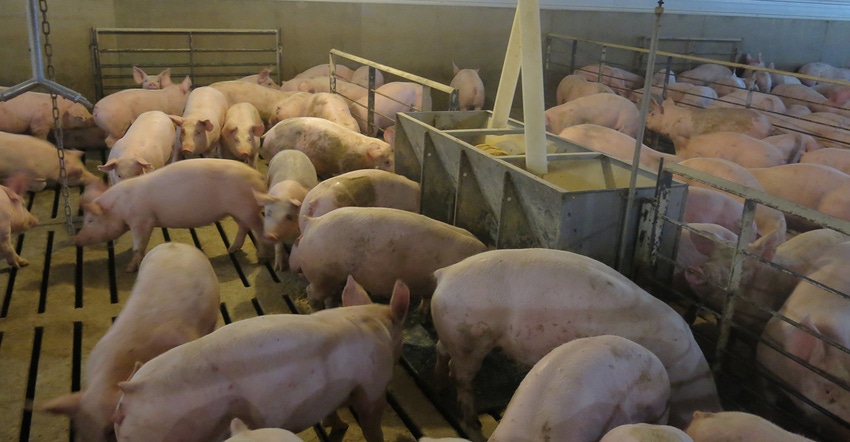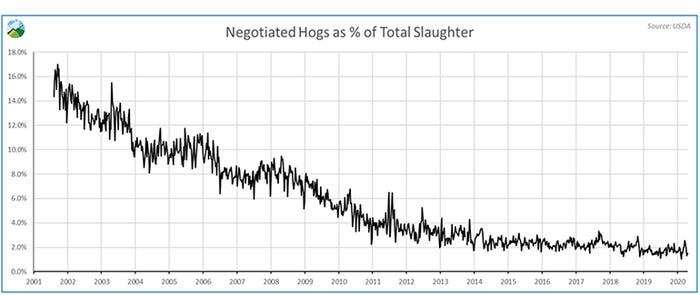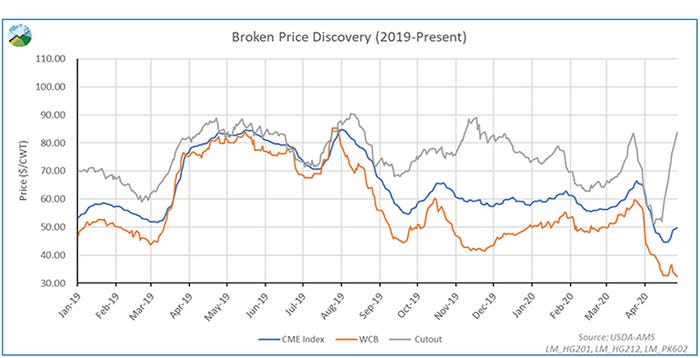Don't let perfect be the enemy of good
There are statistical tests that the accountants run, and our current hog contract does not come close to meeting these thresholds under most circumstances.
May 18, 2020

A major shift to the better, in my opinion, is stirring as the CME Group to reconsidering the listing of the "cutout contract" after a groundswell of support from the pork production community. This does little to address our current quagmire of backed up hog inventory, however it does pave the way for a more equitable distribution of profits up and down the system when we return to our new normal.
A little history lesson may be helpful to contextualize this scenario. Change is nothing new in the way we treat futures contracts and the way they are transacted. In 1997, the CME took the bold (and correct) step to move away from a live animal reference that was deliverable and transitioned to a lean hog contract that is cash settled. While not perfect, it was certainly better than its predecessor.
In 2003, the CME took the additional step to change the settlement procedure from the cash quote to the index. This was the first hint that the negotiated market was fading, and it was a reasonable effort to address the situation. Unfortunately, the cash negotiated quantity of hogs has done nothing but evaporate until we find ourselves in a current scenario where — even pre-COVID — we were trading roughly 1.5% of our daily harvest with negotiated animals. With the closing/slowing of packing plants, we currently have no economic price discovery matrix for a spot market pig whatsoever. (graph attached)
There is no valid economic justification for a 5-cent bid right now and a 40-cent bid. The packer that is bidding 40 is doing so out of compassion and with a long-term view of his operation — his business model needs cash hogs in the future years, and he needs independent pork producers to remain viable to supply him animals. He could just as easily bid 5 cents; get all the animals he needs and prosper in the short term.
I applaud the few packers that are supporting the cash market and not allowing the complete collapse of the spot price. They are doing us a huge favor and we need to be conscious of their altruism on the backside of this crisis. The bottom line is this: the cash market is broken.
Who is to blame for this situation? The packer? The banker? The CME? How about none-of-the-above. Pork producers who failed to support the cash negotiated contract only have themselves to blame for its demise. My esteemed colleague, Steve Meyer, has spent the past several years beating this drum and will reference the economic idiom of "The Tragedy of the Commons" to any audience that wants to hear the message.
Apparently, hearing is not the same as listening as our declining volume of cash negotiated hogs has led us to this dire moment of reckoning. We have to do something different. We no longer farm with a John Deere Model A, regardless of its rhythmic and nostalgic engine sound. The same is true for the hog market. It is OK to view the cash discovery market with a warm whim of what was. It no longer serves the industry and trying to get this dead horse to run is simply foolish for those who seek economic prosperity. It is time to recognize and accept change.
Simply put, there is no need for the packer to negotiate for animals when they are all priced as committed supply and your beating your head against that wall is probably not warranted. Especially when it is not effective.

Which leads us back to the point of this column, the transition to a cutout-based contract in conjunction with or as an alternative to your current index-settled lean hog contract. The current contract is serving no one with its settlement procedures. To wit, we just took the May contract off the board at just below $70 while the cutout was well over $100 (and those with pricing based off of the cutout doing just fine if they can get their animals into the packing plant) and the cash negotiated market below $40.
All of this while pork producers were making the horrific decision of whether or not to euthanize market-ready animals that had no place to go. Now, just where does the $70 settlement value come from? It is a mathematical computation that is not reflective of anyone in the scenario described above.
The CME in its current iteration is not an effective hedge for the producer and — perhaps more importantly — the Internal Revenue Service. Yes, that three letter acronym that sends shivers up your spine. In order for a hedge derivative to be considered viable (and not mere speculation) there has to be a correlation between the item you are hedging and the derivative (the CME hog contract relative to our live animals in our business) that is utilized.
There are statistical tests that the accountants run via their Financial Accounting Standards Board processes — our current hog contract does not come close to meeting these thresholds under most circumstances. Again, we have to do something different. Below is a table from our friends at CIH that depicts this loss of correlation.

The addition of or the conversion to a cutout settled contract attempts to address this issue. Most agreements have moved away from solely derived cash price discovery such as the Western Corn Belt or the Iowa-southern Minnesota into a different method or a blend of markets. A cutout-based futures contract would provide correlation for those that are not based on a cash negotiated market. If you are priced on the Western Corn Belt, your hogs might have nearly identical genetics and phenotype characteristics as those that are alongside of a producer delivering hogs priced off the cutout. The only difference is the price received — a spread of $150 per hog in many cases as of this writing. It is time for a change.
Here is a link to the verbiage from the CME from their 2015 proposal to settle to the cutout, I would suspect this will serve as a core for the settlement index verbiage should this change occur. A shift to a CME cutout-based settlement is not perfect, but it is significantly better than what we are experiencing now. Below is a chart of the brokenness of price discovery.

Comments in this column are market commentary and are not to be construed as market advice. Trading is risky and not suitable for all individuals.
Source: Joseph Kerns, who is solely responsible for the information provided, and wholly owns the information. Informa Business Media and all its subsidiaries are not responsible for any of the content contained in this information asset. The opinions of this writer are not necessarily those of Farm Progress/Informa.
About the Author(s)
You May Also Like





